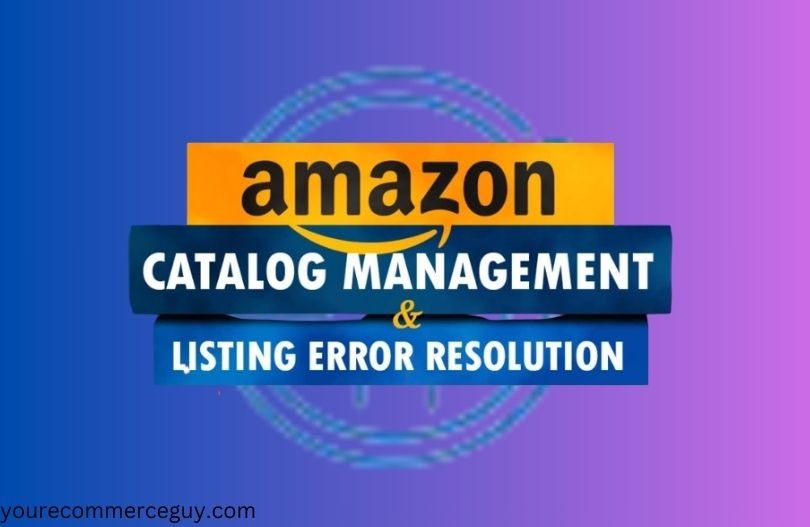

Introduction:
In the vast landscape of e-commerce, Amazon stands tall as the go-to platform for millions of sellers worldwide. However, even the most robust ecosystems encounter challenges, and for Amazon sellers, catalog issues have become a prevalent concern. In this blog, we’ll delve into the intricacies of Amazon catalog issues, shedding light on the common hurdles faced by sellers and offering insights on how to navigate through them.
Understanding Amazon Catalog Issues:
Amazon’s extensive catalog, comprising millions of products, is a double-edged sword. While it provides customers with an unparalleled selection, it also poses challenges for sellers. Catalog issues can manifest in various forms:
- Incomplete Listings: Sellers often find themselves dealing with incomplete product listings, missing crucial details that could impact visibility and sales. Inaccurate or insufficient information can lead to potential customers overlooking your product.
- Duplicate Listings: Duplicate listings can dilute the visibility of your product and create confusion for customers. Amazon’s algorithm may struggle to identify the primary listing, affecting your product’s search ranking.
- Incorrect Categorization: Products placed in the wrong categories can hinder discoverability. Sellers may find their items lost in a sea of unrelated products, making it difficult for customers to find what they’re looking for.
- Image and Content Issues: High-quality images and compelling product descriptions are crucial for attracting customers. Catalog issues may arise if your images are unclear or if your product descriptions lack the necessary details.
- Variation Management Problems: Sellers offering product variations (e.g., different sizes, colors) may encounter challenges in managing and displaying these variations effectively.
Navigating Amazon Catalog Issues – A Seller’s Guide:
- Regular Audits: Conduct regular audits of your product listings to ensure completeness and accuracy. Verify that all vital information, such as titles, descriptions, and images, is up to date and in compliance with Amazon’s guidelines.
- Utilize Amazon’s Tools: Leverage Amazon’s Seller Central tools, such as the Listing Quality Dashboard, to identify and address catalog issues promptly. These tools provide insights into the health of your listings and offer recommendations for improvement.
- Optimize Product Titles and Descriptions: Craft clear, concise, and keyword-rich product titles and descriptions. This not only improves the searchability of your products but also enhances the customer’s understanding of what you’re offering.
- Address Duplicate Listings: If you encounter duplicate listings, take steps to merge or eliminate them. This ensures that your product’s visibility isn’t diluted, and customers can easily find the correct version.
- Stay Informed: Keep yourself informed about changes in Amazon’s policies and guidelines. Staying abreast of updates will help you proactively address catalog issues and adapt to the evolving e-commerce landscape.
FAQ’S
Q1: What are common catalog issues on Amazon that sellers face?
A1: Sellers on Amazon often encounter issues such as incomplete listings, duplicate listings, incorrect categorization, image and content problems, and challenges in managing variations for their products.
Q2: How can sellers identify catalog issues on their Amazon account?
A2: Sellers can utilize tools provided by Amazon, such as the Listing Quality Dashboard, to monitor the health of their product listings. Conducting regular audits of product information and staying informed about changes in Amazon’s policies are also effective ways to identify catalog issues.
Q3: Why is it important to address catalog issues on Amazon?
A3: Addressing catalog issues is crucial for maintaining the visibility and competitiveness of your products. Incomplete or inaccurate listings can lead to decreased visibility, potentially impacting sales and customer trust.
Q4: How can sellers optimize their product listings to avoid catalog issues?
A4: Sellers can optimize their product listings by ensuring complete and accurate information, using high-quality images, crafting clear and keyword-rich titles and descriptions, and placing products in the correct categories.
Q5: What steps can sellers take to resolve duplicate listings on Amazon?
A5: Sellers can resolve duplicate listings by merging or eliminating them through Amazon Seller Central. It’s essential to maintain a single, accurate listing to avoid confusion among customers and improve search ranking.
Q6: Can catalog issues affect a seller’s Amazon search ranking?
A6: Yes, catalog issues can impact a seller’s search ranking on Amazon. Inaccurate or incomplete listings may result in lower visibility, making it difficult for potential customers to find the products.
Q7: How often should sellers conduct audits of their Amazon product listings?
A7: Sellers should conduct regular audits of their product listings on Amazon, ideally on a monthly basis. This helps in identifying and addressing catalog issues promptly, ensuring the accuracy and completeness of product information.
Conclusion:
While navigating Amazon catalog issues may seem like a daunting task, proactive measures and a commitment to maintaining accurate and compelling product listings can significantly enhance your success as a seller on the platform. By addressing catalog issues head-on, you not only improve your product’s visibility but also contribute to a positive customer experience, ultimately leading to increased sales and growth for your Amazon business.
